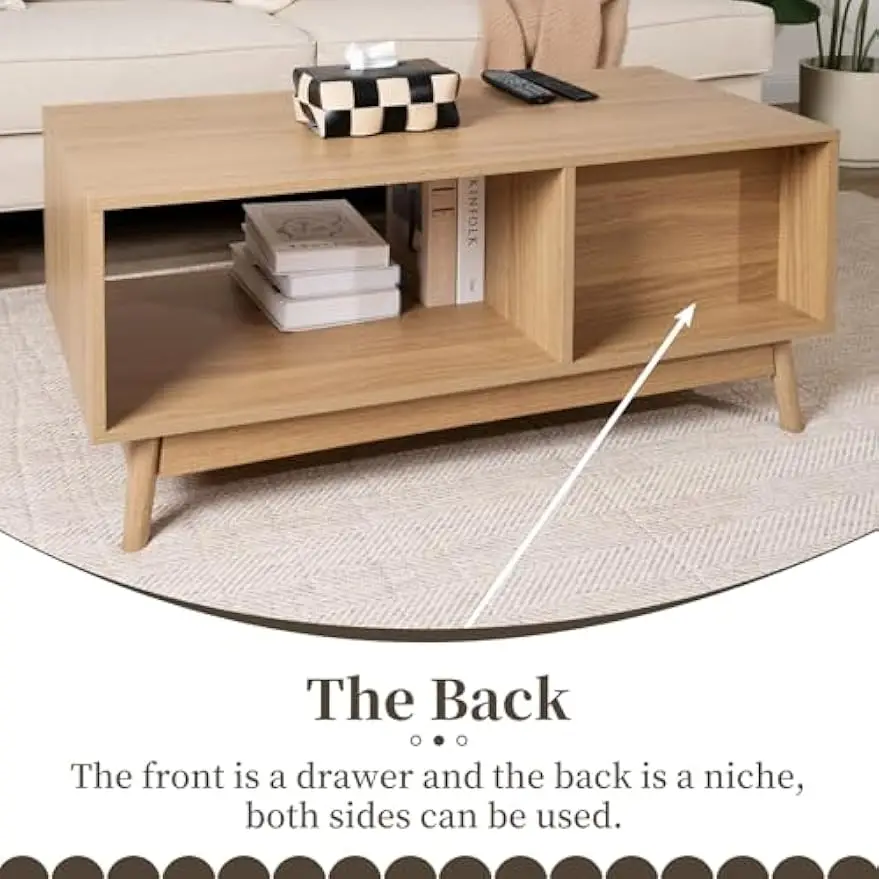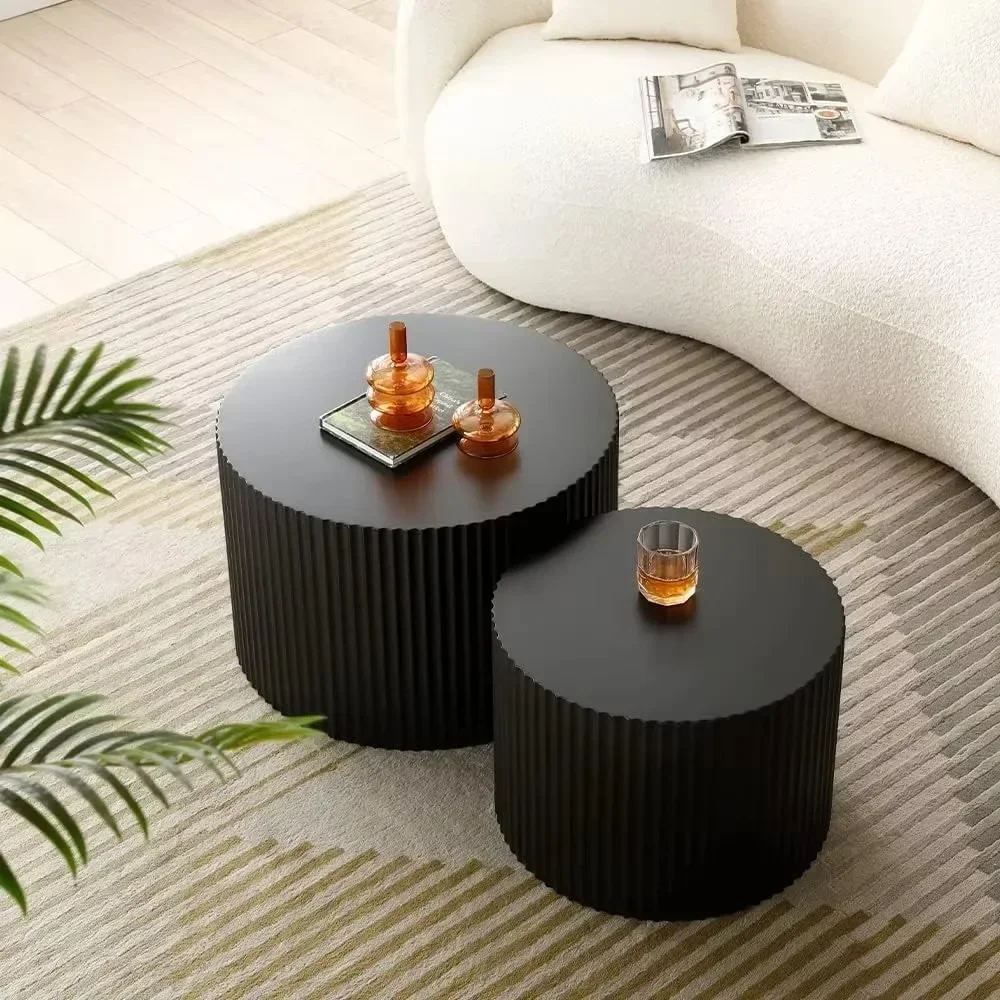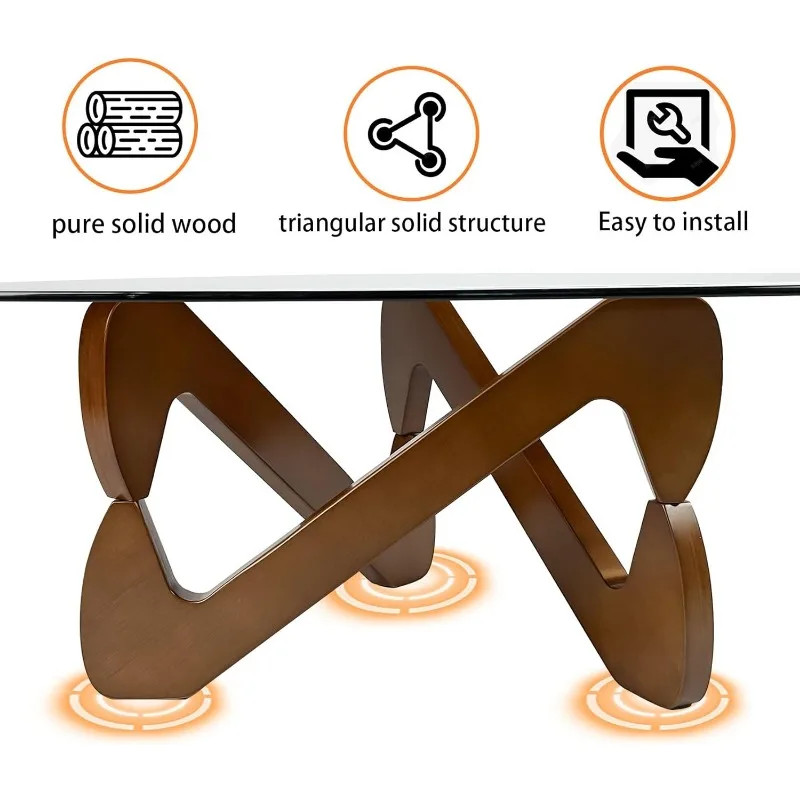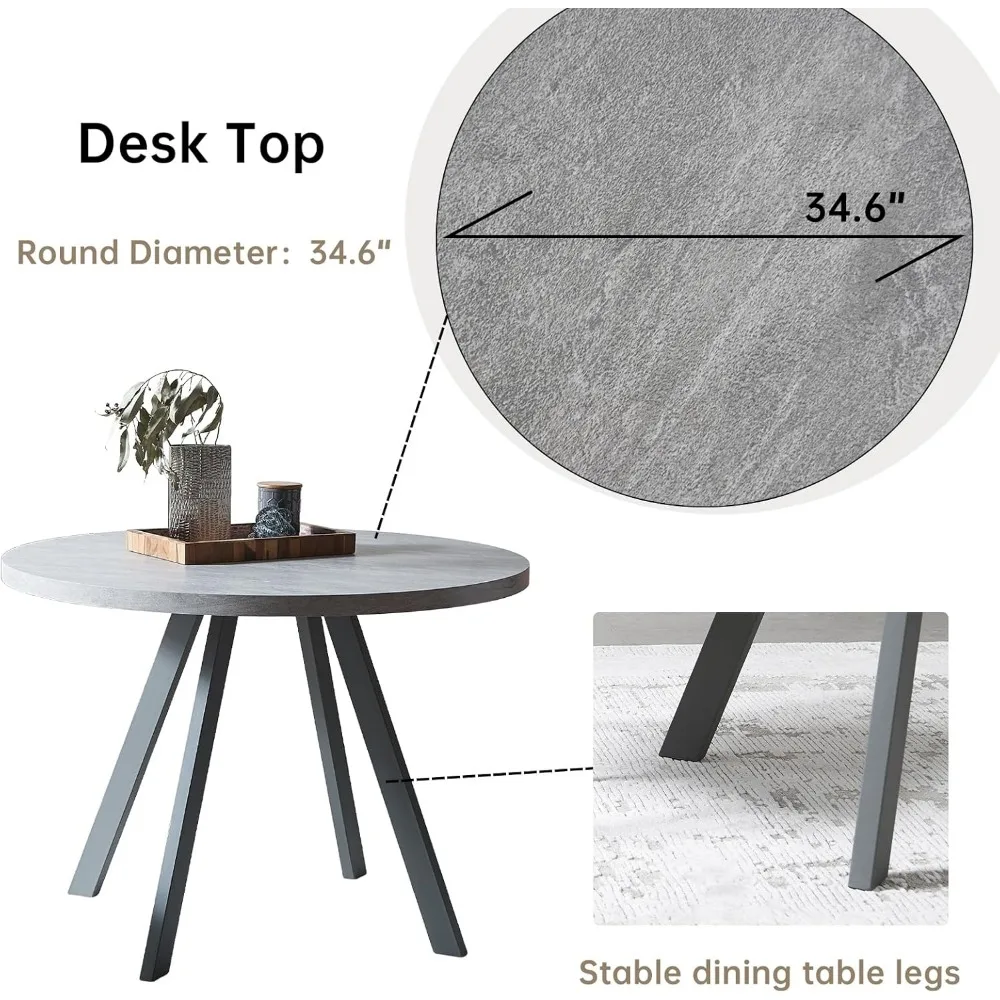The Essence of Large Mid-Century Modern Tables
Mid-century modern design represents one of the most influential furniture movements of the 20th century. Born from the innovative spirit of the post-war era, this design philosophy embraces clean lines, functional forms, and an honest approach to materials. Large mid-century modern tables exemplify these principles while making bold statements in living and dining spaces.
What makes a mid-century modern table “large” goes beyond mere dimensions. These pieces command attention through their substantial presence, typically stretching 72-96 inches in length to comfortably accommodate 6-12 people. Yet despite their imposing size, they maintain a sense of visual lightness through clever design techniques.
The enduring appeal of these tables stems from their perfect balance of form and function. Unlike ornate traditional furniture, large mid-century coffee tables prioritize purposeful design that remains as relevant today as when first introduced. Their timeless quality makes them both historical treasures and contemporary statement pieces.
Signature Aesthetic Features of Large Mid-Century Modern Tables
The distinctive appearance of mid-century modern tables emerges from several key design principles that set them apart from other furniture styles:
Clean Lines and Geometric Forms
Mid-century modern tables feature straightforward, uncluttered silhouettes that reject unnecessary ornamentation. The emphasis on pure geometric forms—rectangles, ovals, circles—creates a sense of visual clarity and purpose. This simplicity allows the beauty of materials and proportions to take center stage.
Organic Influences
Despite their geometric foundations, many mid-century designs incorporate subtle organic elements inspired by nature. Soft curves, kidney-shaped surfaces, and flowing edges add warmth and approachability to these pieces. This blending of geometric discipline with natural forms creates the signature mid-century aesthetic.
Visual Lightness
Perhaps most remarkably, large mid-century tables manage to appear visually light despite their substantial size. Designers achieved this effect through raised profiles, tapered elements, and strategic material use. The result is furniture that creates minimal visual weight even while providing ample surface area.
The design advantages of large mid-century coffee tables continue to influence contemporary furniture creators who appreciate how these pieces solve practical problems while maintaining aesthetic integrity.
Distinctive Leg Designs That Define the Style
The legs of mid-century modern tables serve as both structural elements and defining aesthetic features:
Tapered Legs: Perhaps the most recognizable mid-century element, these legs start wider at the top and narrow toward the floor. They can be straight or angled outward (splayed), creating a sense of dynamic energy.
Hairpin Legs: These slender metal supports bring industrial influence to mid-century design, providing structural integrity while maintaining visual lightness.
Pedestal Bases: Sculptural single supports like the iconic Tulip design create an elegant silhouette while maximizing leg room.
Wishbone/V-shaped Supports: These angular designs add visual interest through geometric tension, often connecting to central beams rather than table corners.
Exploring mid-century modern large coffee tables reveals how these distinctive leg designs contribute to the overall character and stability of these pieces.
Material Excellence: The Foundation of Quality MCM Tables
Mid-century modern design celebrates authentic materials, allowing their natural properties to enhance both form and function. Superior material selection distinguishes quality pieces from mass-produced imitations.
Premium Hardwoods
Warm, natural hardwoods dominate mid-century table design, with walnut, teak, oak, and rosewood being the most prized varieties. These materials were selected for their rich color variation, distinctive grain patterns, and structural integrity. Finishes typically enhance rather than disguise the wood’s natural character, using oils and light stains that allow grain patterns to show through.
Metal Elements
Strategic use of metal—particularly brass, stainless steel, and chrome—provides both structural support and visual contrast in many designs. Metal elements might appear as leg ferrules, edge banding, or hardware, adding subtle industrial elegance while reinforcing structural integrity.
Glass and Stone
Table surfaces sometimes incorporate glass or stone elements to add durability and visual interest. Marble, particularly in white varieties, creates sophisticated contrast against warm woods, while glass tops allow the base construction to become more visible.

Wood Features: The Heart of Mid-Century Craftsmanship
The masterful use of wood defines authentic mid-century tables. Key wood features include:
Distinctive Grain Presentations: Book-matching (mirroring grain patterns) and continuous grain alignment create visually striking surfaces.
Natural Finishes: Oil-based finishes that penetrate the wood rather than forming thick surface layers allow the material to age gracefully.
Veneer Artistry: While solid wood components provide structural integrity, carefully selected veneers allow for dramatic grain patterns and resource efficiency.
Aging Characteristics: Quality hardwoods develop rich patinas over time, becoming more beautiful with use—unlike engineered wood products that degrade.
Mid-century modern solid wood coffee tables showcase these material qualities, while mid-century modern walnut coffee tables specifically highlight the most iconic wood type associated with this design period.
Scale and Proportion: What Makes These Tables “Large”
Large mid-century modern tables command attention through their significant dimensions while maintaining harmonious proportions. Understanding these dimensional relationships helps explain why these pieces work so well in varied spaces.
Dining Table Dimensions
Typical large mid-century dining tables range from 72-96 inches (183-244 cm) in length, accommodating 6-12 people comfortably. Width typically stays proportional at 36-48 inches (91-122 cm), creating the balanced rectangular form characteristic of these tables. Height remains consistent at approximately 29-30 inches (74-76 cm), regardless of length, ensuring ergonomic comfort.
Coffee Table Scale
Oversized mid-century coffee tables typically measure 48-60 inches (122-152 cm) in length with widths of 24-36 inches (61-91 cm). Despite their substantial footprint, these pieces maintain visual lightness through raised profiles and thoughtful proportions.
Proportional Balance
What distinguishes these tables is their careful attention to proportional relationships. Table thickness, leg dimensions, and overall height maintain consistent ratios regardless of surface size. This mathematical harmony creates pieces that feel “right” even when scaled up significantly.
Learning to expertly arrange rooms with large coffee tables helps homeowners maximize both functionality and aesthetic appeal in their spaces.
Functional Innovations in Large Table Design
Beyond their striking appearance, large mid-century modern tables incorporate clever functional innovations that enhance their versatility and usability.
Space-Saving Extensions
Many large dining tables feature ingenious extension systems that allow them to accommodate varying numbers of guests. These mechanisms remain hidden when not in use, preserving clean lines while offering remarkable adaptability.
Edge Profiles
Table edges receive careful attention in mid-century design. Slightly rounded or beveled edges create a more comfortable user experience while subtly softening the geometric form. Some designs feature dramatic edge treatments that become defining characteristics of the piece.
Surface Treatments
Surfaces often incorporate protective finishes that resist heat, moisture, and wear without compromising appearance. These practical considerations ensure these tables can withstand daily use while maintaining their beauty.
Understanding the various functional uses of round mid-century tables demonstrates how these practical considerations influenced even the most artistic designs.
Extension Systems: Versatility Without Compromise
Extension mechanisms represent some of the most innovative aspects of large mid-century table design:
Butterfly Leaves: These hinged extensions fold and store within the table itself, eliminating the need for separate storage.
Drop-In Leaves: Removable sections can extend table length by 12-24 inches (30-61 cm) per leaf, often with clever storage solutions built into table aprons.
Draw-Leaf Extensions: These pull-out sections remain attached to the table, sliding from underneath to create additional surface area.
Self-Storing Mechanisms: Many designs incorporate internal storage compartments for extensions, maintaining clean lines when not in use.
Browsing mid-century modern rectangular coffee tables reveals how designers incorporated these extension principles across various table types.
Table Shapes and Their Spatial Impact
The shape of a large mid-century table significantly influences both its visual presence and how people interact around it. Different shapes create distinct spatial dynamics:
Rectangular Tables
The classic rectangular form provides efficient seating arrangements and fits naturally in most dining rooms. These tables establish a sense of order and formality while maximizing seating capacity. Rectangular designs typically seat people along the long edges with optional head positions at the short ends.
Oval/Racetrack Tables
By eliminating sharp corners, oval tables create smoother circulation around the piece while maintaining the efficient seating arrangement of rectangular tables. The softened geometry creates a more conversational atmosphere while preserving seating capacity.
Round Tables
Large round mid-century tables foster democratic interaction by placing all seats at equal distance from the center. Though less common in very large sizes due to structural challenges, these designs create unique social dynamics that encourage conversation across the entire table.
Boat-Shaped Tables
This elegant variation features subtle curves that narrow at each end, creating a sophisticated silhouette. The gentle taper maintains generous center width while reducing visual bulk at the ends.
Large rectangular and round mid-century tables each create different effects in dining spaces, influencing both traffic flow and social interaction.

Construction Quality Markers in Authentic MCM Tables
The construction techniques used in genuine mid-century modern tables reveal the craftsmanship that distinguishes quality pieces:
Superior Joinery
Quality mid-century tables feature sophisticated joinery methods that ensure structural integrity without relying heavily on hardware:
- Mortise and tenon joints create strong connections between legs and aprons
- Dovetail construction provides exceptional strength in drawers and extensions
- Finger joints allow for secure wood-to-wood connections in complex forms
Hardware Integration
When hardware is used, it’s typically minimal and purposefully integrated into the design. Brass fittings, steel reinforcements, and specialty hinges function as both structural elements and subtle design details.
Underside Finishing
Even unseen surfaces receive careful attention in quality pieces. Examining the underside of a table often reveals thoughtful details like finished edges, structural reinforcements, and intentional material selection rather than cheap substitutions.
Understanding mid-century modern table design principles helps buyers identify authentic pieces that will maintain their integrity for generations.
Mid-Century Modern Solid Wood Coffee Tables, Mid-Century Modern Teak Coffee Tables
$879.95 Select options This product has multiple variants. The options may be chosen on the product pageMid-Century Modern Danish Coffee Tables, Mid-Century Modern Oval Coffee Tables, Mid-Century Modern Solid Wood Coffee Tables
$390.05 Select options This product has multiple variants. The options may be chosen on the product pageMid-Century Modern Coffee & End Table Sets, Mid-Century Modern Coffee Table Sets, Mid-Century Modern Oval Coffee Tables
Price range: $257.48 through $331.04 Select options This product has multiple variants. The options may be chosen on the product pageMid-Century Modern Glass Top Coffee Tables, Mid-Century Modern Glass Top Side & End Tables
$460.58 Select options This product has multiple variants. The options may be chosen on the product pageMid-Century Modern Glass Top Coffee Tables, Mid-Century Modern Vintage Coffee Tables, Mid-Century Modern Vintage Side & End Tables
$725.36 Select options This product has multiple variants. The options may be chosen on the product pageMid-Century Modern Lift Top Coffee Tables, Mid-Century Modern Square Coffee Tables
$454.73 Select options This product has multiple variants. The options may be chosen on the product page
How to Choose the Right Large MCM Table for Your Space
Selecting the perfect large mid-century modern table requires careful consideration of your space and needs:
Room Dimensions
Measure your room carefully, allowing for proper circulation space around the table. Generally, maintain at least 36 inches (91 cm) between the table edge and walls or other furniture to ensure comfortable movement. Remember that chairs require approximately 24-30 inches (61-76 cm) of pullout space.
Visual Weight
Consider how the table’s visual weight impacts your space. Tables with slender legs and minimal aprons appear lighter and work well in smaller rooms, while more substantial pieces can anchor larger spaces without overwhelming them.
Material Selection
Choose materials that complement your lifestyle needs. Families with young children might prefer durable solid wood surfaces, while design enthusiasts entertaining occasionally might select more dramatic materials like marble or glass.
Complementary Pieces
Consider how the table will relate to existing furniture. The strong character of mid-century pieces works best when given room to breathe rather than competing with too many other statement pieces.
For detailed guidance on accommodating larger pieces, explore resources on mastering space planning for oversized mid-century coffee tables.
Accessorizing Large Mid-Century Modern Tables
Styling large mid-century modern tables enhances their impact while maintaining their functional purpose:
Complementary Seating
Select chairs that honor the table’s design language without competing for attention. Classic mid-century chairs with similar leg styles and compatible wood tones create cohesive dining ensembles. For coffee tables, surrounding seating should maintain proportional relationships.
Appropriate Lighting
Pendant lighting suspended 24-36 inches (61-91 cm) above dining tables provides both functional illumination and visual anchoring. Select fixtures with compatible materials and forms—brass, walnut, or simple geometric shapes echo mid-century principles.
Tabletop Styling
Accessories should complement rather than overwhelm these tables. Select a few quality objects with clean lines and interesting materials rather than cluttering the surface with too many items. Ceramics, simple textiles, and architectural objects in complementary materials enhance the mid-century aesthetic.
For coffee tables specifically, maximizing versatile appeal of large mid-century coffee tables requires balancing display opportunities with functional needs.

The Timeless Appeal of Large Mid-Century Modern Tables
The enduring popularity of large mid-century modern tables speaks to their exceptional design integrity. By prioritizing honest materials, purposeful forms, and meticulous craftsmanship, these pieces transcend trends to become lasting design statements.
What distinguishes these tables is their remarkable balance of artistic expression and everyday functionality. They solve practical problems while elevating ordinary activities through thoughtful design. This combination of beauty and utility represents the core philosophy of mid-century design.
At Hearth Forms, we recognize that these iconic tables continue to resonate because they connect us to design principles that remain relevant across generations. Their honest approach to materials and purpose-driven forms create gathering places that enhance our daily rituals and spaces.
Explore our collection of mid-century modern coffee tables to discover pieces that honor these timeless design traditions while serving contemporary needs.







